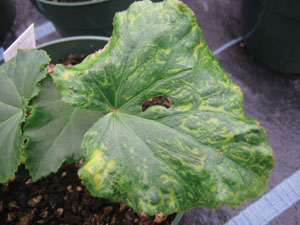2/15/2009
The Right Light for Hiemalis Begonas
Mark Klemmedson

Excess light levels seem to be the source of more growers’ problems than any other issue when growing Hiemalis, or Elatior, begonias. When growers call with a problem or I’m visiting a greenhouse and notice a problem, more often than not it’s caused by excess light.
Begonias can grow in a wide range of light levels, and good growers will learn to change light intensity in order to profitably grow beautiful begonias. Optimum growth occurs at low light levels between 1,000 and 2,500 foot-candles, but light levels too low will lead to leggy plants. Slightly higher light levels still give a fast growth rates but cause very compact growth and prolong the finishing time. Even higher light levels will slow the growth rate, because of the light stress, and cause stunted plants.
On the plus side, these response characteristics allow light levels to be used as a growth regulator. To reduce crop time, I start plants under low light to optimize growth rate until a certain height is achieved, then move on to spacing the crop under a moderate light level. Higher light can then be used to keep plants compact for weeks until they can be sold.
Watch for bright days
Many growers who grow only a spring crop of Hiemalis begonias often grow without shade, not knowing the light preferences of begonias. The plants are started in the winter when the sun isn’t so intense, and they gradually harden as the days get longer and brighter in the spring, never getting excessive burn. Occasionally growers will experience an exceptionally bright winter day. Two weeks after the bright day, they call me, wondering if their begonias have a virus. They haven’t realized the damage was caused by that one extremely sunny day. A slight sunburn on begonias will damage the upper surface of the leaf, causing leaf distortions and color patterns as the leaf expands, similar to virus symptoms.
I’ve found little difference in light tolerance between different Hiemalis begonia varieties, even though some publications state differently. Some varieties naturally grow leggy but will grow compact under higher light levels. These are not necessarily high-light varieties, but they may be preferable for growers who want to grow begonias but don’t have a low-light growing area. Under high-light conditions these leggy varieties will grow more compact, but growers have to be extra careful to avoid sunburn.
Here comes the sun
Begonias prefer lower light levels, but under the right circumstances can tolerate full sun. In some ways they respond to the sun similarly to humans. The first couple times I go out in the sun each summer I get sunburned, but after I get a base tan I can spend longer periods of time in the sun without getting burned. Begonias are the same. If they’re slowly hardened off to the sun they can tolerate quite a bit of sun exposure. If not hardened off, they can be severely burned when put in full sun. Begonias can also take more sun under conditions that keep the leaf temperature cool, so they can often be in full sun in the morning or winter when cool air temperatures and air movement keep the leaf temperature down. In the Seattle area, we tell our customers that a location with morning sun and afternoon shade is the optimum location for a Hiemalis begonia. With high light and protection from the hot sun, they’ll grow compact with lots of flowers all summer and into the fall.
Mark Klemmedson is owner and president of Klem’s Greenhouse, a Hiemalis begonia specialist in Redmond, Washington, www.klemsgreenhouse.com.